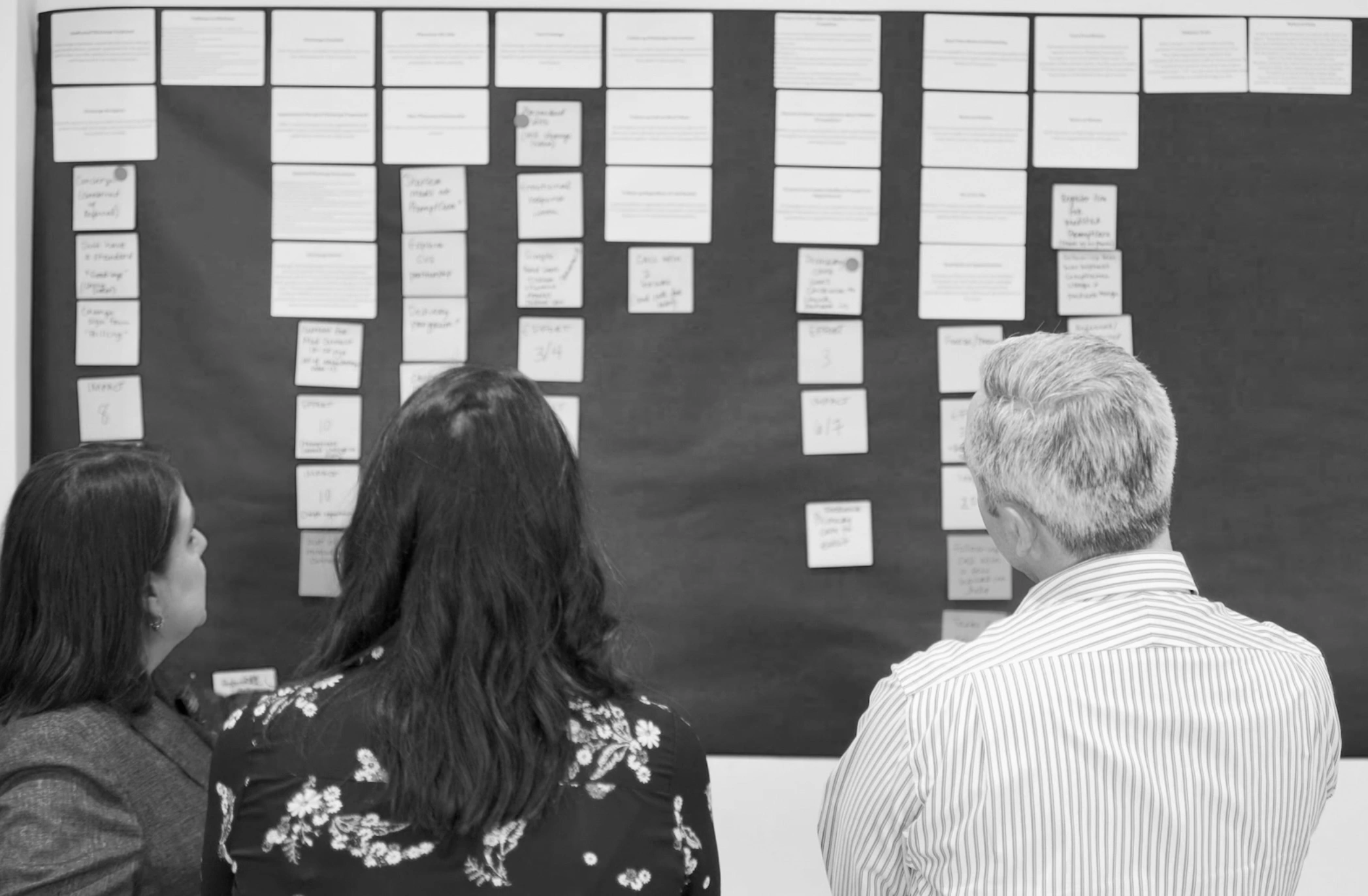Design thinking solves a wide range of challenges — maybe even one you’re facing right now. Read some examples of situations that design thinking is well-suited to help with.
Feel like you’ve hit a wall?
Some problems are easy to solve with a team brainstorm or a tweak to a process. Others are bigger, messier, and keep resurfacing no matter how many times you try to solve them.
If you’re facing the second kind of challenge, design thinking might just be your path to a breakthrough.
Design thinking is a structured, collaborative approach to problem-solving that involves end users (often customers and employees) in creating the solution. For a deeper understanding of the process, read our comprehensive guide to design thinking.
Until you’ve tried the framework, it’s hard to know if it’s the right approach for the situation you’re up against. If you’re exploring different avenues, here are the kinds of scenarios where design thinking offers value.
Challenges that design thinking can help with
The kinds of problems that are best suited for design thinking have a few common characteristics.
These problems tend to be:
- Complex: The issue has layers and nuances that prevent it from being solved with a quick fix or by a single department.
- Persistent: You might have tried multiple solutions, and none were truly effective.
- Open-ended: “Doing things the way they’ve always been done” may have proven to be ineffective with this problem. It’s more ambiguous, and will require a creative solution.
You might not immediately spot these traits in the specific challenge you’re facing right now. Read on for 3 examples showing how they translate into common business challenges.
If you can relate to any of the following situations, your problem is a good candidate for design thinking.
Situation 1: Dealing with a challenge that keeps resurfacing
Feel like you’re rehashing the same challenge year after year, without real progress?
It’s not for lack of ideas or effort. In the past, maybe:
- Your team landed on a solution, but couldn’t secure approval to move forward with it.
- The idea wasn’t practical to roll out.
- You implemented changes, but they didn’t fix the root issue.
In healthcare, for example, a hospital might invest in staff training and upgraded facilities to improve patient satisfaction scores — only to see little change, because the underlying issue of patients feeling unheard wasn’t solved.
Design thinking helps break the cycle of ineffective problem-solving by involving the right people (patients, leaders, and staff) early in the process, so solutions align with business objectives and address the heart of the issue.

Situation 2: Launching innovations that miss the mark
Have you ever sunk time and resources into a new feature, product, or service, only to watch it fail in the market?
Many organizations have an inside-out approach to innovation. Instead of starting with, “What do our customers want and need?” they ask, “What can we create next?”
We see this in SaaS, for example, when companies release new product features that go unused. If the features lack desirability — if nobody wants them — the investment becomes a waste of resources. (And customers start wondering why they’re paying for “all of these features that I don’t need.”)
Design thinking solves this issue by developing empathy for end users. This helps teams better understand their customers’ needs and launch innovations that people want.
Situation 3: Missing opportunities your competitors are seizing first
Do you often feel a step behind your competitors?
Opportunities can slip by if you aren’t:
- Anticipating evolving consumer expectations
- Able to move quickly when new ideas emerge
- Using data to prioritize which solutions you push forward
Few fast food chains thought to serve breakfast until McDonald’s released the Egg McMuffin in the ‘70s and dominated the scene. Decades later, breakfast is a must-have for fast food brands — and many are still trying to catch up to McDonald’s momentum.
Design thinking helps organizations avoid blindspots and stay agile by deeply understanding consumers, iterating quickly, and blending diverse perspectives to surface breakthroughs.
Benefits of using design thinking for these kinds of problems
What makes design thinking effective in solving challenges like the ones above? The framework includes key steps that can strengthen solutions and improve business outcomes.
The benefits of design thinking include:
- Building empathy: Interviews and collaborative workshops help teams truly understand customers — and each other — leading to more human-centered, effective solutions.
- Breaking down silos: Design thinking brings people from across the organization together, promoting buy-in and improving the odds of success.
- Validating ideas: One of the key benefits of design thinking in innovation is ensuring solutions are desirable, feasible, and viable — preventing significant investment into an idea that’s doomed to fail.
- Accelerating iteration: Design thinking encourages prototyping and testing solutions with end users, both early and often. As a result, teams learn quickly, adjust course, and make progress without wasting months on the wrong path.
- Shifting mindsets: Instead of asking “What can we make?” design thinking prompts teams to ask, “What do people actually need?” That shift creates a ripple effect, shaping a more human-centered company culture.
Design thinking solves root causes of problems, leads to innovations that meet customer needs, and helps reveal blindspots — directly addressing the 3 scenarios above (among others).
Facing a challenge like these?
Design thinking might be the approach that helps you solve it, once and for all. Our design thinking workshops help teams uncover their best ideas and move forward with solutions that work.

.webp)


.png)
.webp)


.png)